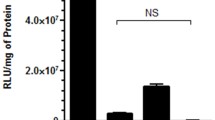Abstract
The transport of exogenous DNA into the nucleus of eukaryotic cells is a prerequisite for successful gene delivery. To favor nuclear transport we synthesized a tetramer of the nuclear localization signal (NLS) of the SV40 large T-antigen as a novel nonviral gene delivery vector. This 4.4-kDa lysine-rich peptide (NLSV404) binds and compacts DNA by electrostatic interaction and forms stable polyplexes. Apart from its sequence-specific potency to mediate nuclear accumulation of conjugated albumin, NLSV404 also displays properties of nuclear transport for plasmid DNA as confirmed by fluorescence in situ hybridization. Further, NLSV404 polyplexes are shown to efficiently transfect various cell lines such as 16HBE14o–, HeLa S6, and Cos7 cells. NLSV404 polyplexes displayed at least 20-fold higher transfection rates than analogous polyplexes formed by the nuclear transport-deficient mutant sequence cNLS. Using growth-arrested cells, NLSV404 complexes were at least 100-fold more efficient than cNLS complexes. Combination of NLSV404 peptide but not of cNLS peptide with preformed polyethylenimine and dendrimer DNA complexes resulted in a strong increase in transfection efficiency. Incubation of cells prior to transfection with NLSV404 polyplexes with excess free peptide NLSV404 but not with cNLS resulted in a dose-dependent dramatic decrease in the transfection rate, suggesting a sequence-specific competitive inhibition. These results indicate that NLSV404 mediates nuclear accumulation of transfected plasmid DNA and that it can be a highly useful component of nonviral gene vectors.









Similar content being viewed by others
Abbreviations
- BSA-BODIPY :
-
Fluorescence-labeled bovine serum albumin
- EGFP :
-
Enhanced green fluorescent protein
- FISH :
-
Fluorescent in situ hybridization
- NLS :
-
Nuclear localization signal
- PEI :
-
Polyethylenimine
- SV40 :
-
Simian virus 40
References
Zabner J, Fasbender AJ, Moninger T, Poellinger KA, Welsh MJ (1995) Cellular and molecular barriers to gene transfer by a cationic lipid. J Biol Chem 270:18997–19007
Pollard H, Remy JS, Loussouarn G, Demolombe S, Behr JP, Escande D (1998) Polyethylenimine but not cationic lipids promotes transgene delivery to the nucleus in mammalian cells. J Biol Chem 273:7507–7511
Brunner S, Sauer T, Carotta S, Cotten M, Saltik M, Wagner E (2000) Cell cycle dependence of gene transfer by lipoplex, polyplex and recombinant adenovirus. Gene Ther 7:401–407
Brunner S, Furtbauer E, Sauer T, Kursa M, Wagner E (2002) Overcoming the nuclear barrier: cell cycle independent nonviral gene transfer with linear polyethylenimine or electroporation. Mol Ther 5:80–86
Gorlich D, Mattaj IW (1996) Nucleocytoplasmic transport. Science 271:1513–1518
Nigg EA (1997) Nucleocytoplasmic transport: signals, mechanisms and regulation. Nature 386:779–787
Jans DA, Hubner S (1996) Regulation of protein transport to the nucleus: central role of phosphorylation. Physiol Rev 76:651–685
Kalderon D, Roberts BL, Richardson WD, Smith AE (1984) A short amino acid sequence able to specify nuclear location. Cell 39:499–509
Goldfarb DS, Gariepy J, Schoolnik G, Kornberg RD (1986) Synthetic peptides as nuclear localization signals. Nature 322:641–644
Richardson WD, Roberts BL, Smith AE (1986) Nuclear location signals in polyoma virus large-T. Cell 44:77–85
Ciolina C, Byk G, Blanche F, Thuillier V, Scherman D, Wils P (1999) Coupling of nuclear localization signals to plasmid DNA and specific interaction of the conjugates with importin alpha. Bioconjug Chem 10:49–55
Sebestyen MG, Ludtke JJ, Bassik MC et al (1998) DNA vector chemistry: the covalent attachment of signal peptides to plasmid DNA. Nat Biotechnol 16:80–85
Zanta MA, Belguise-Valladier P, Behr JP (1999) Gene delivery: a single nuclear localization signal peptide is sufficient to carry DNA to the cell nucleus. Proc Natl Acad Sci USA 96:91–96
Kalderon D, Richardson WD, Markham AF, Smith AE (1984) Sequence requirements for nuclear location of simian virus 40 large-T antigen. Nature 311:33–38
Schermelleh L, Solovei I, Zink D, Cremer T (2001) Two-color fluorescence labeling of early and mid-to-late replicating chromatin in living cells. Chromosome Res 9:77–80
Ernst N, Ulrichskotter S, Schmalix WA et al (1999) Interaction of liposomal and polycationic transfection complexes with pulmonary surfactant. J Gene Med 1:331–340
Collas P, Alestrom P (1998) Nuclear localization signals enhance germline transmission of a transgene in zebrafish. Transgenic Res 7:303–309
Plank C, Tang MX, Wolfe AR, Szoka FCJ (1999) Branched cationic peptides for gene delivery: role of type and number of cationic residues in formation and in vitro activity of DNA polyplexes. Hum Gene Ther 10:319–332
Plank C, Oberhauser B, Mechtler K, Koch C, Wagner E (1994) The influence of endosome-disruptive peptides on gene transfer using synthetic virus-like gene transfer systems. J Biol Chem 269:12918–12924
Gorlich D, Kutay U (1999) Transport between the cell nucleus and the cytoplasm. Annu Rev Cell Dev Biol 15:607–660
Clamme JP, Azoulay J, Mely Y (2003) Monitoring of the formation and dissociation of polyethylenimine/DNA complexes by two photon fluorescence correlation spectroscopy. Biophys J 84:1960–1968
Radler JO, Koltover I, Salditt T, Safinya CR (1997) Structure of DNA-cationic liposome complexes: DNA intercalation in multilamellar membranes in distinct interhelical packing regimes. Science 275:810–814
Acknowledgements
We thank the Förderverein für mukoviszidosekranke Kinder und Jugendliche der Region Ulm e.V. for financial support to purchase a fluorescence microscope. This work was supported by grants from the Bundesministerium für Bildung und Forschung, Bonn, Germany (01 GE9617/9, 01 GE0002, and 01 KV9554/1) and by the Deutsche Forschungsgemeinschaft (RO994/2–1).
Author information
Authors and Affiliations
Corresponding author
Rights and permissions
About this article
Cite this article
Ritter, W., Plank, C., Lausier, J. et al. A novel transfecting peptide comprising a tetrameric nuclear localization sequence. J Mol Med 81, 708–717 (2003). https://doi.org/10.1007/s00109-003-0483-2
Received:
Accepted:
Published:
Issue Date:
DOI: https://doi.org/10.1007/s00109-003-0483-2




